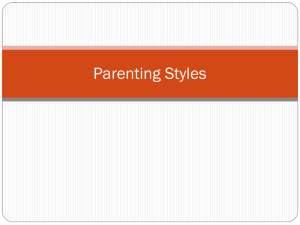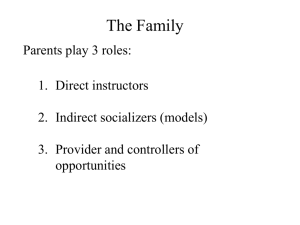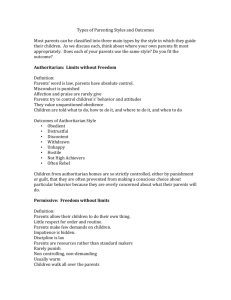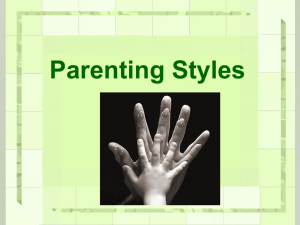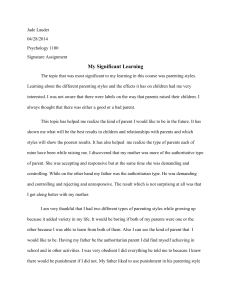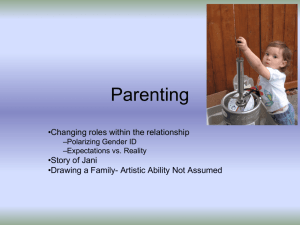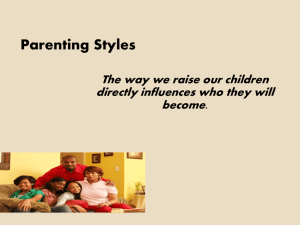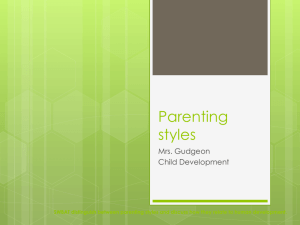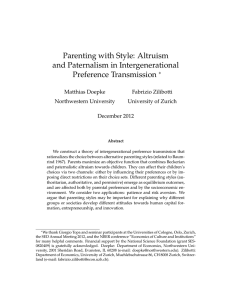Parenting Styles and Outcomes
advertisement
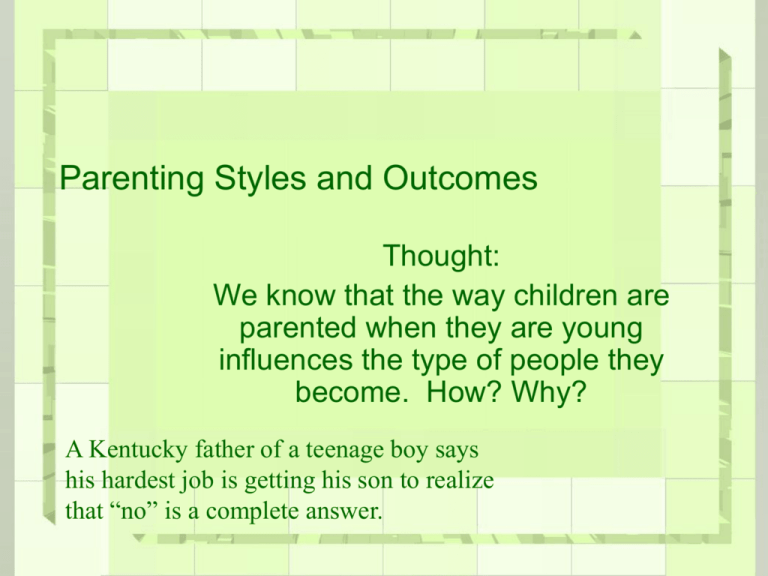
Parenting Styles and Outcomes Thought: We know that the way children are parented when they are young influences the type of people they become. How? Why? A Kentucky father of a teenage boy says his hardest job is getting his son to realize that “no” is a complete answer. Competencies / Objectives The student will be able to: • Identify parenting styles, including positive guidance techniques that help children develop positive selfconcepts, self-management, and responsibility. • Identify parenting types and styles. • List ways to foster a child’s self-concept. • Identify positive guidance techniques. • Write an abstract and a personal analysis of a child guidance articles. • Apply positive guidance techniques to child-rearing problems and/or case studies. Match 1. Responsive to children's’ needs. 2. Indifferent to children, ignore them 3. Reject their children 4. Critical, derogatory, dissatisfied with their children. 5. Warm, understanding and accepting. A. Hostile and antisocial B. Poor self-control, difficulty with social interactions when teenagers. C. Compliant with parent’s wishes D. Happy and friendly E. Dissatisfied with themselves. Matching Key 1. Responsive to children's’ needs. 2. Indifferent to children, ignore them 3. Reject their children 4. Critical, derogatory, dissatisfied with their children. 5. Warm, understanding and accepting. A. Hostile and antisocial B. Poor self-control, difficulty with social interactions when teenagers. C. Compliant with parent’s wishes D. Happy and friendly E. Dissatisfied with themselves. Types of Parenting Styles and Outcomes Most parent can be classified into three main types by the style in which they guide their children. As we discuss each, think about where your own parents fits most appropriately. Do each of your parents use the same style? Do you fit the outcome? Authoritarian: Limits without Freedom. Definition: Parents’ word is law, parents have absolute control. Misconduct is punished Affection and praise are rarely give Parents try to control children's’ behavior and attitudes They value unquestioned obedience Children are told what to do, how to do it, and where to do it, and when to do it. Outcomes of Authoritarian Style •Obedient •Distrustful •Discontent •Withdrawn •Unhappy •Hostile •Not High Achievers •Often Rebel Children from authoritarian homes are so strictly controlled, either by punishment or guilt, that they are often prevented from making a conscious choice about particular behavior because they are overly concerned about what their parents will do. Permissive: Freedom without limits. Definition: Parents allow their children to do their own thing. Little respect for order and routine. Parents make few demands on children. Impatience is hidden. Discipline is lax Parents are resources rather than standard makers Rarely punish Non controlling, non-demanding Usually warm Children walk all over the parents Outcome of Permissive Parenting •Aggressive •Least self— reliant •Least selfcontrolled •Least exploratory •Most unhappy Children from permissive homes receive so little guidance that they often become uncertain and anxious about whether they are doing the right thing. Democratic: Freedom within limits. Definition: Middle ground between the two above Stress freedom along with rights of others and responsibilities of all Parents set limits and enforce rules Willing to listen receptively to child’s requests and questions. Both loves and limits Children contribute to discussion of issues and make some of their own decisions Exert firm control when necessary, but explain reasoning behind it. Respect children’s interest, opinions, unique personalities. Loving, consistent, demanding Combine control with encouragement Outcomes of Democratic Style •Happy •Mostly self-reliant •Mostly selfcontrolled •Content, friendly, generous •Cooperative •High-achiever’ •Less likely to be seriously disruptive or delinquent Children whose parents expect them to perform well, to fulfill commitments, and to participate actively in family duties, as well as family fun, learn how to formulate goals. They also experience the satisfaction that comes from meeting responsibilities and achieving success. In groups of three or four have student develop a case study or story that fits each parenting style. Have group pass their stories to other group and have them read them to see if they can identify the parenting style. Activity: Fingerprints, Activity: Fingerprints, page 168, More Activities That Teach, Tom Jackson, IBSN #0-9664633-3-1 Ways to foster a child's selfesteem. Provide more successes than failures for the child. Give uncondition al love. Eliminate the negative. Give lots of encouragement. Give them freedom to fail with acceptance. Allow independence. Do not set standards unreasonably high. Avoid ridicule. Ways to foster a child's selfesteem. Be available. Give your children responsibility Take their ideas, emotions and feelings seriously. Set Limits Be a good role model. Help your child develop talents Allow exploration and encourage questions. Assignment: Building Selfesteem In each of the situations, what would you say or do to build a child’s selfesteem? Speaking Positively activity: Don’t -Please Do Show and Discuss the Positive Guidance Techniques PowerPoint Presentation from the Child Discipline and Guidance Lesson Plan on UEN. Assignment: What are some appropriate solutions to the following situations? Assignment: What are some appropriate solutions to the following situations? 1. Tommy is throwing a ball in the living room and knocks over a lamp. 2. Nicole is throwing sand at the other kids in the sand pile. 3. Your three children are bickering in the backseat while you are driving on the interstate. 4. Jerry, eating in a restaurant with you, creates a disturbance and humiliates you by belching and giggling loudly. 5. Amy keeps forgetting to take her lunch money to school. You are always having to remind her to do it or take it to her at school. 6. Jon won’t come in the house when you call him for dinner. 7. Heather takes her brother’s money from his piggybank and spends it. 8. Your teenager keeps the car out past the agreed time. 9. Jocelyn refuses to do her homework. 10. Craig leaves his dirty clothes on the floor instead of putting them I’m Hooked Have students complete the I’m Hooked Sheet (write down what you learned today and how will you use this in your life). Summary: One of the most important things to remember as a parent is to be yourself. You can only use those methods with which you feel comfortable. A child can spot a fake a mile away. Children know if you mean what you say or if it is just another threat. Select the methods that you believe in, that you feel comfortable with, and then be consistent.
